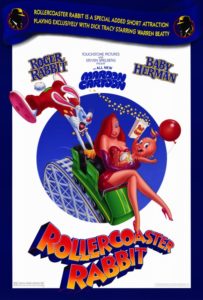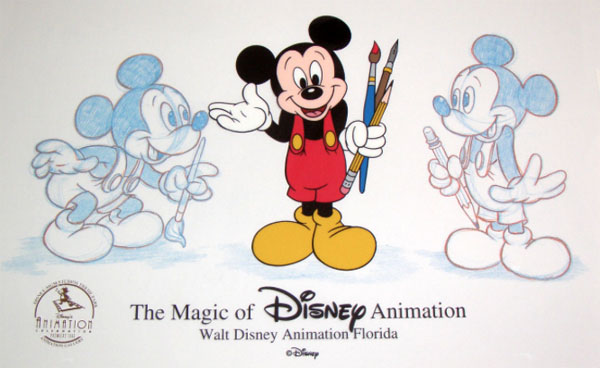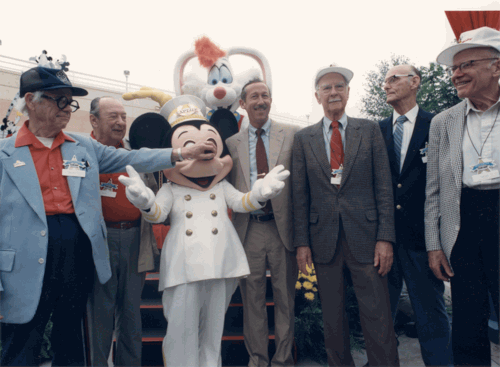
The official description from 1989 of The Magic of Animation pavilion at Disney MGM Studios was “The new Animation Building at the Disney-MGM Studios is a working animation studio that just happens to have visiting hours. The magic of Disney animation is created here, every day, by a staff of over eighty talents artists and technicians who are producing new featurettes, starring classic Disney characters, for theatrical and cable release.
“Inside: Films provide the insiders’ view of animation. Exhibits explain the intrcacies of ink and paint, extremes and in-betweens. The Disney Animation Collection presents stunning art from sixty years of animated filmmaking. Guests watch from soundproof walkways as animators create new adventures for beloved Disney characters.”
Following in the tradition of the Art of Animation exhibit that was at Tomorrowland at Disneyland from May 28, 1960 to September 5, 1966 that tried to explain the process of animation, display Disney art and then provide related merchandise like How to Draw books, cels and flip books, the Magic of Disney Animation pavilion tried to “plus” that experience.
In 1988, WDI approached former Imagineer Bob Rogers and his BRC company to create a tour of a working animation studio to handle approximately a thousand guests an hour. In addition, BRC was responsible for scripting and producing the three different films shown during the tour: Back to Neverland, Animators on Animation and Disney Classics.
The experience began in a movie theater (this theater and the finale theater each holding approximately 250 audience members), then moved through all the departments of an animation studio–storyboard, layout, character animation, etc.–in elevated tiered passageways that allowed the guests to view the artists behind glass enclosures. On overhead screens, brief animated segments helped explain what was happening in each step of the process.
The animators at Disney Feature Animation Florida referred to this area as “the fishbowl” referencing that they felt like goldfish in a bowl being constantly looked at by gawkers as they did their regular tasks. They sometimes put signs or things on their desks to amuse the guests, including occasionally inappropriate items or tried to locate themselves towards the back of the room.
 “I worked on Roller Coaster Rabbit (1990) short at the Florida studio and was in the fish bowl for most of it,” remembered my long time friend, animator Mark Kausler who also worked on the Back to Neverland short. “I remember shooting a scene on 3/4 inch video one day and looked up to see Jeffery Katzenberg looking at me from the other side of the glass! I picked a good time to be shooting!
“I worked on Roller Coaster Rabbit (1990) short at the Florida studio and was in the fish bowl for most of it,” remembered my long time friend, animator Mark Kausler who also worked on the Back to Neverland short. “I remember shooting a scene on 3/4 inch video one day and looked up to see Jeffery Katzenberg looking at me from the other side of the glass! I picked a good time to be shooting!
“Michael Eisner occasionally dropped in on us wearing shorts and sneakers and a Mickey T-shirt. Singer Rosemary Clooney and cartoonist Jim Davis (Garfield) came by and so many others. It’s so hard to realize that the whole Florida studio is history now.
“I didn’t hate being on display in Florida so much; they took such good care of us that you couldn’t complain. There was a pitch room for story and music right next to the glass and sometimes we would gather in there and pretend to pitch story ideas to amuse the guests.”
At the end of the tour, guests queued up in a carpeted lobby area for their final film experience in another movie theater which was a retrospective montage collection of clips of highlights from Disney animated films.
While waiting to enter the Disney Classics Theater to see this show, on the walls of the lobby were screens with short clips of Disney animators talking about the creation of Disney characters and their love of animation called “Animators on Animation”. When it finished, an animator or show artist was seated in front of an animation desk on a elevated platform showing how to draw a character and discussing animation (and sometimes avoiding the often-asked question of what films he had worked on and what he did).
After the finale film, guests moved into a museum-like display of artwork, cels, maquettes, duplicates of Oscars won by Disney for animation and more items usually promoting the latest Disney animated project and then exited into a store selling animation related merchandise.
This original version of the tour ran from opening day until it closed on September 30th, 2003 where it was replaced with a much different version since the Disney Feature Animation Florida unit had been dissolved.

For the original tour, guests quickly determined that the best time to visit was usually Monday through Friday from 10:00 am to 5:00 pm because it coincided with the regular working hours of the artists. Although occasionally, there might be a small handful of people working in the evenings or on weekends, in general, it was during the weekday hours that most of the areas were filled.
In 1998, Disney Feature Animation Florida moved from temporary backstage trailers into a new $70 million facility designed specifically for animation that was connected to the area with the tour. At the studio’s height in the mid-1990s, it employed approximately 400 artists and technicians.
To consolidate production, the Disney Company closed its Orlando annex division officially on Monday, January 12th, 2004 as well as its animation annex studios in Paris and Tokyo and the animation building was converted into office space for different departments.
The new version of the animation tour that began in 2004 reversed the pathway and began in the Disney Classics Theater where guests interacted with a Disney show artist (not necessarily an actual Disney animator) who bantered with an animated Mushu the small dragon from Mulan (1998), ironically a film made entirely at the Florida studio.
Then guests journeyed pass display cases, an interactive area including an opportunity to learn how to draw a Disney character and meet Disney costumed characters. This version closed on July 12th, 2015 and the area was remade into the Star Wars Launch Bay.

On May 1st, 1989, the pavilion was dedicated.
Roy E. Disney talked at a podium set up in the front of the attraction where he emphasized that hand drawn animation was really the focal point of the Disney Company. He continued to talk about the fact that animation was the start of the Disney Company and that with the newly opened Disney Feature Animation Studio Florida “a new day for animation will be dawning”.
The animated feature film The Little Mermaid would debut in November, just six months later, proving Roy absolutely correct.
Joining in the dedication were several Disney Legends who had made significant contributions to animation: Frank Thomas, Ollie Johnston, Ward Kimball, Marc Davis, Ken O’Connor and Ken Anderson. O’ Connor was there because he had worked as an art consultant on the Back to Neverland short film in the pavilion.
There was also a ceremony where these six animation legends put their handprints and autographs (along with imprints of their drawing pencils) into cement blocks to be placed in an alcove of the outdoor animation courtyard inside the building.
Those hidden handprints were available for every guest to enjoy until they were removed when the Star Wars Launch Bay opened on December 1st, 2015.
So, today, where once guests eagerly learned the secrets of Disney animation and watched talented artists hard at work, now they greet Kylo Ren and Chewbacca and enjoy galleries and games themed to a galaxy far, far away.
Disney Films Done at Disney Feature Animation Florida:
The Little Mermaid (1989) — Florida artists contributed ink and paint support to the film
The Rescuers Down Under (1990) — About 10 minutes of the 77-minute sequel to 1977’s The Rescuers was animated in Florida, as well as 10 minutes of the Mickey Mouse short feature The Prince and the Pauper double-billed with the movie.
Beauty and the Beast (1991) — Florida animators assisted in the “Be Our Guest” sequence.
 The Lion King (1994) — Florida animators provided about 20 minutes of the film, including the “I Just Can’t Wait to be King” sequence
The Lion King (1994) — Florida animators provided about 20 minutes of the film, including the “I Just Can’t Wait to be King” sequence
Pocahontas (1995) — Florida animators contributed about 18 minutes to the film, including scenes involving Pocahontas’ father, Chief Powhatan.
The Hunchback of Notre Dame (1996) — Florida animators were only responsible for about 4 minutes of this movie, including scenes involving both Quasimodo and the villain Judge Frollo.
Mulan (1998) — This was the first animated feature film produced primarily by Walt Disney Feature Animation Florida at Disney-MGM Studios, all while theme park guests watched. It is also the first Disney animated feature made outside of Burbank.
The Emperor’s New Groove (2000) Additional Animation Production Services
Dinosaur (2000) Additional Animation Production Services
Atlantis: The Lost Empire (2001) Additional Animation Production Services
Lilo and Stitch (2002) — Made almost entirely in Florida, this film was nominated for an Academy Award for best animated feature.
Brother Bear (2003) — The last major film to be released by the Florida studio. In development at the time was another feature entitled “My Peoples” (also known as “A Few Good Ghosts” and “Once in a Blue Moon”) that was cancelled.
Other projects done at the Feature Animation Florida included the Roger Rabbit short cartoons Tummy Trouble (1989), Rollercoaster Rabbit (1990) and Trail Mix-Up (1993), the shorts John Henry (2000), Off His Rockers (1992), How to Haunt a House (1998) for Toon Disney featuring Goofy, a Manatee PSA (1992), and in 1993 “The House meets The Mouse Parts 1 and 2” (A Non-Disney Project for Warner Bros. Television’s Full House) (Animated Segment for “Joey’s Caricature” and Cameo (Uncredited except for Mark Henn)).


 Jim Korkis is an internationally respected animation historian who in recent years has devoted his attention to the many worlds of Disney. He was a columnist for a variety of animation magazines. With his former writing partner, John Cawley, he authored several animation related books including The Encyclopedia of Cartoon Superstars, How to Create Animation, Cartoon Confidential and Get Animated’s Animation Art Buyer’s Guide. He taught animation classes at the Disney Institute in Florida as well as instructing classes on acting and animation history for Disney Feature Animation: Florida.
Jim Korkis is an internationally respected animation historian who in recent years has devoted his attention to the many worlds of Disney. He was a columnist for a variety of animation magazines. With his former writing partner, John Cawley, he authored several animation related books including The Encyclopedia of Cartoon Superstars, How to Create Animation, Cartoon Confidential and Get Animated’s Animation Art Buyer’s Guide. He taught animation classes at the Disney Institute in Florida as well as instructing classes on acting and animation history for Disney Feature Animation: Florida.




















































Wasn’t “Home On The Range” the last Orlando feature? (Maybe I am mis-remembering this.)
Home on the Range was produced in Burbank.
I went to the Animation studio during it’s very first week. Got there to n a Monday, around 11 am, not one person working. Super disappointed.
I went to the Magic of Animation attraction in 2010. I went to a class where they showed us how to draw Donald Duck (I still have my drawings from that!). They had storyboards from TOY STORY 3 on display as well as a bunch of the Oscars from the Disney cartoons. In the gift shop, I remember seeing a picture of the characters from DUMBO parading around the Walt Disney Studio in Burbank.
Mark Henn was stationed in the Orlando studio (I met him there in late 1991) and I would assume he animated Belle from there too.
[Mulan] is also the first Disney animated feature made outside of Burbank.
Believe that honor goes to Duck Tales the Movie: Treasure of the Lost Lamp (1990).
The Ducktales movie (Treasure of The Lost Lamp) was not considered canon, ie: an official Disney feature.
Cool article, brings back a lot of happy memories from when I worked there. Good to see my good friend, Disney artist Les Carpenter at work.
Fun article, thanks! Brings backlots of memories. A few notes…
– Beauty and the Beast- I don’t recall us doing any of the “Be Our Guest” seq. unless it was some of the digital scenes, dancing forks, spoons, etc. We did do the Beast bandaging seq. after the wolf attack, much of “The Mob Song” and the “Something There” song.
– Aladdin- Mark Henn supervised the character of Jasmine from the FL studio. We also had an Aladdin unit overseen by Alex Kupershmidt (Supervised by Glen Keane in Burbank).
– The Lion King- Two characters were supervised from Florida, Young Simba by Mark Henn and Young Nala by Aaron Blaise. Also, Alex Kupershmidt (from Florida) did much of the Hyena animation when Nala and Simba were cubs.
-Pocahontas- Ruben Aquino led the character of Chief Powhatan from FL.
– Other projects- We didn’t do Tummy Trouble in FL, just RCR and TMU. We also did projects for the parks such as “It’s a Small World” for Euro Disney (I think), a Figment interactive attraction for Epcot and Aladdin animation for the old Sega Genesis game system. There were many other projects done in FL when the Special Animation services unit was created.
Again, fun article. Thanks!
IIRC my first visit was during a soft opening of the park before it was even officially opened. I was tickled, therefore, that in the Robin Williams pre-show there’s footage of him outside the building, in a busy park surrounded by “guests”. They would have had to have all been castmembers and actors, the footage shot long before the park was even finished. Still better, though, than the rear-projected park “visits” Walt would fake in the 50s for the “Disneyland” TV show.
There must have been other Beauty and the Beast material done there, because in their camera room I saw running on a loop the zoom-in to Chip looking through the window of Maurice’s cottage.
I also saw Roller Coaster Rabbit being produced there. A nice touch they had was, behind the first window they’d have a long display of storyboard art from whatever they were working on. It was not positioned in a way that would be at all useful to the people working there, so it was just for show, but it was still a neat glimpse into production.
As things were winding down there, during one walkthrough there was one lonely person inking Mickey sericels.
My last visit was after there was no more production but there was still a tour, so someone would sit at an animation desk and give general vague info and draw characters for kids…but while they could draw, they were not animators, and if you asked them anything technical they were lost.
When they drew animation at desks. Count me as wistful.
I wrote about the studio for Animato not long after it opened, in what I think was the first article I ever wrote involving going somewhere and interviewing people. Among them: Mark Henn and Mark Kausler.
When Epcot opened, there were information terminals throughout the park called World Key, where cast member could help you with questions and reservations on a screen, which was a wondrous thing back then. The Jiminy Cricket animation was done by artists in Florida who worked for an area of WED that became Marketing Art.
The other “fishbowls” at the Florida studios were at the sound stages, where guest could watch movies and TV shows being produced through the windows. There was a spectacular standing set for the Disney Channel show “Adventures in Wonderland” that resembled an elaborate Sid & Marty Krofft Pufnstuf set that guests could see for months.
Post production allowed people to see people like me working on TV specials and commercials as we edited, sound mixed and recorded. We also ate lunch and had meetings as hundreds of people went by, about 30 or so at a time. It looked like that Star Trek episode, “The Mark of Gideon:”
https://www.youtube.com/watch?v=KdsbuJfMpr0
Many guests were not sure we could see them, so once in a while we would wait until just before they were about to leave, and they go into enthusiastic waving. It surprised and delighted the nice folks. Good times.
It’s a shame Disney made the decision to close this attraction. I hope Disney decides to re-open this attraction, that is, if they ever even want to continue with hand-drawn animation. 2D animation can’t die at Disney, it just can’t. That was part of the foundation of Disney Animation to begin with.
Wasn’t Tarzan or parts of it also made in Orlando?